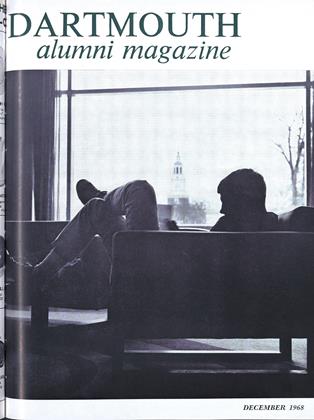By Edwin B.Coddington '29. New York: CharlesScribner's Sons, 1968. 866 pp. $15.
A few weeks ago, visiting a friend near Gettysburg (not the General), I had occasion to tour the battlefield again. The day was clear, visibility excellent, and the color of the foliage at its best. From Lookout Tower, one could see the entire battlefield stretched out below, almost like a map - the Peach Orchard and Devil's Den, where Longstreet's Corps attempted to turn the Union left flank, Little Round Top, Seminary Ridge, and the open field across which Pickett's men charged toward the Union forces on Cemetery Ridge.
There is no denying the attraction of Gettysburg not only for the familiarity of the scene but also for its importance and drama. It was, in the late Edwin Coddington's words, "the midway point" of the Civil War - a gamble Lee took and lost. For more than 100 years, the campaign has been the center of controversy. The strategy of the opposing generals has been debated heatedly, each action described at length and analyzed in detail, and tales of the heroic deeds performed during the three days of the battle endlessly repeated.
Despite the number of times the battle has been described, Professor Coddington, formerly chairman of the history department at Lafayette, manages to give it freshness and new meaning. Utilizing a wide variety of manuscript materials, some never before used, he has given us the fullest account to date of the battle. Starting of with Chancellorsville, he traces the beginnings the campaign in Lee's desire to regain the initiative for the South and relieve the pressure on Vicksburg. He carefully examines both sides in the battle, their numbers, weapons, equipment, state of training, brings all elements into position at Gettysburg, examines the terrain, and analyzes the plans of the commanders. His approach is slow and deliberate, but by the time the reader reaches the first day of the battle on page 260, he knows every inch of the ground and the men who occupy it.
Coddington does not settle all the controversies surrounding Gettysburg, but he deals with them as satisfactorily and fully as one would wish. Meade comes off better than Lee in his account; even the Union general's decision not to pursue is defended persuasively. Each of the major decisions of the campaign is treated in turn and judgment rendered after careful and judicious examination. Though one may disagree with the judgment, one can hardly fault the author for failure to consider all sides of the question. Coddington spent many years on this book, and it is not likely that his work will be surpassed for many more years.
Chairman of Dartmouth's Department ofHistory, Mr. Morton holds the Chair ofDaniel Webster Professor of History.
 View Full Issue
View Full Issue
More From This Issue
-
 Feature
Feature"Our trusty and well-beloved John Wentworth Esq., Governor"
December 1968 By Susan Liddicoat -
 Feature
FeatureOf Peaceful Men and Violent Ideas
December 1968 By DEAN THADDEUS SEYMOUR -
 Feature
FeaturePolitical Year 1968: A Reprise
December 1968 By EDWARD W. GUDE '59, INSTRUCTOR IN GOVERNMENT -
 Class Notes
Class Notes1934
December 1968 By STANLEY H. SILVERMAN, EDWARD S. BROWN JR. -
 Article
ArticleThe Faculty
December 1968 By WILLIAM R. MEYER -
 Class Notes
Class Notes1935
December 1968 By RICHARD K. MONTGOMERY, C. HALL COLTON
LOUIS MORTON
-
 Feature
FeatureWAR AND HISTORY
FEBRUARY 1963 By LOUIS MORTON -
 Books
BooksMILITARISM, U.S.A.
OCTOBER 1970 By Louis Morton -
 Books
BooksTHE AMERICAN CAMPAIGNS OF ROCHAMBEAU'S ARMY 1780, 1781, 1782, 1783. Vol. 1. THE JOURNALS OF CLERMONT-CREVECOEUR, VERGER, AND BERTHIER. Vol. 2. ITINERARIES AND MAPS AND VIEWS.
MARCH 1973 By Louis Morton -
 Books
BooksTHE WAGES OF WAR 1816-1965: A STATISTICAL HANDBOOK.
MARCH 1973 By Louis Morton -
 Books
BooksJUSTICE UNDER FIRE: A STUDY OF MILITARY LAW.
July 1974 By LOUIS MORTON
Books
-
 Books
BooksFACULTY PUBLICATIONS
April 1940 -
 Books
BooksProfessor Roy P. Forster
November 1946 -
 Books
BooksTHE ANCESTRY OF THE LONGLIVED.
November 1934 By C.H. Forsyth -
 Books
BooksROBOTS OR MEN?
MAY 1930 By Louis W. Ingram -
 Books
BooksA REFERENCE GUIDE TO THE STUDY OF PUBLIC OPINION.
November 1934 By Paul Allen '26 -
 Books
BooksANTICIPATING YOUR MARRIAGE.
November 1955 By RALPH P. HOLBEN
More From This Issue
LOUIS MORTON
-
 Feature
FeatureWAR AND HISTORY
FEBRUARY 1963 By LOUIS MORTON -
 Books
BooksMILITARISM, U.S.A.
OCTOBER 1970 By Louis Morton -
 Books
BooksTHE AMERICAN CAMPAIGNS OF ROCHAMBEAU'S ARMY 1780, 1781, 1782, 1783. Vol. 1. THE JOURNALS OF CLERMONT-CREVECOEUR, VERGER, AND BERTHIER. Vol. 2. ITINERARIES AND MAPS AND VIEWS.
MARCH 1973 By Louis Morton

